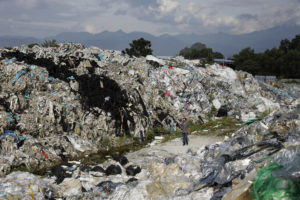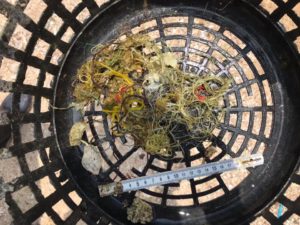
Many might have heard “please classify the garbage”, but it may not go like the way that you have expected it to be. The garbages really get classified but where did they go after they were classified. Some goes to landfills, some goes to trash incinerators, some were dumped to the oceans. A research from HuffPost’s article shows that Southeast Asian is the dumping grounds for developed countries. The “developed countries” such as United States, EU, and Japan have been exporting their recyclable wastes but the importers found out that those are not really effective.
According to Reuters, the plastic wastes have been found at Southeast Asians like Malaysia and Vietnam for a while. Due to the plastic pollutions which the two countries have been suffering, they also found that only half of the plastics are from them, but the other half came from wealthy countries like the United States, China, New Zealand, and German. That’s because every countries do not want to lose their benefits. It’s real simple, they don’t want to lose their benefits. Malaysia official blames the U.S. official for the plastic wastes that were beached on Malaysia’s coasts while the U.S. blames the China for banning the plastic import which makes the politics involved in this topic. And keep in mind that the population is increasing rapidly and we almost run out of resources. Either save it or the new generations will not have the natural resources to use.

In the article, “Why Southeast Asia Is Flooded With Trash From America And Other Wealthy Nations” by Mosbergen Dominique, shows the behind processes that classifying the garbage isn’t very helpful. Dominique went to Malaysia to find out the truth, and she found that about 50% of the garbage aren’t really from Malaysia, but they were from wealthy countries like United States, Japan, and Europe. Lots of Walmart plastic tags and oreo plastic containers can be found in the area.
“Walmart, which has vowed to reduce waste and to invest in recycling infrastructure, did not respond to questions about the bale found in Malaysia”, a simply replied from Jerry Powell who is executive editor of the industry publication Resource Recycling, “how plastic waste apparently generated at one of its U.S. stores traveled thousands of miles across the ocean only to pollute a Malaysian neighborhood” (Mosbergen 2018).
”Items put in recycling bins, don’t end up being recycled”, says Dominique. Most of the trash had been sitting there for at least eight months, and it’s still increasing. She also says Southeast Asian is the dumping ground of the world, and nobody is doing anything to change that.
“The situation is getting worse, especially with more and more illegal plastic recycling factories,” Yeo Bee Yin, Malaysia’s minister of energy, technology, and environment (Ananthalakshmi, Emily, 2018).
The process of recycling is being question to Malaysia official. They have failed every procedures. Although, the recycling process comes with a pollution risk, it should not be gigantic piles of wastes and plastics. According to “Recycle your plastics”, used plastics will be recycle to pellets which later will be used for manufacturing other plastic products. As aforementioned, the process always come with risks, the plastics that could not be recycled will have to get rid off by burning which is the main cause for global warming. A research says, chinese factories burnt the plastic wastes after the China official announcement.
Local Malaysians asked for their rights. They want the officials from United States, China, or even Malaysia to deal with the illegal plastic waste recycling facilities in their countries because they will not only dump the wastes illegally, but they also make the pollution getting worse by their selfish actions.
The reason behind all of this is China banning the plastic imports which causes huge effects to all over the world, and Malaysia is a great example to show you that. China was a biggest world’s largest importer of recyclables until the end of summer 2017. The announcement has made huge impact to the world because the world will have to deal with massive plastic problem that China won’t do it anymore. However, Basel Convention might play the hero role for the Southeast Asian since Norway suggests adding plastic scrap to the list of materials that Basel Convention will cover, and Malaysia agrees with them. Although, they are still debating whether they should add the plastic scrap to the list of not, Malaysia will not be able to handle the plastic pollution without help from other nations.
It has been almost two years since China announced the ban of plastic imports because China did not want to be the world’s dumping ground anymore. The reason why China banned the plastic imports is because some of them are not really recyclable, so they think they are wasting their money. “Only 9% of discarded plastics are recyclable, 12% has to get rid of by burning, and the rest will have to bury on landfills or dump to the oceans”, basically China thought recycling is futile, and the plastic trades did not benefit them (“Plastic Recycling Is Broken”). China had always imported metric tons of plastics wastes, and China also import 45% of world’s plastic wastes. However, after the announcement plastics have nowhere to go, so it has became a big problem for every countries when China doesn’t want to be the world’s dumping ground anymore. On the other hand, United States, Japan, and Thailand were making profits when it comes to about plastic trades. Although, they know that China were suffering, they still kept going for trades until the announcement came out which shock the world. United states had exported 663 millions of metric tons, and they were making billions from the trades.
“Total plastics exports rose 18.5% in 2000, reaching $30.16 billion”, which make United States the second largest of plastic exporter to China (“SPI Report Examines U.S.”). However, United States has not been exporting plastics to only China, United States has also exported to Mexico, Canada, and Hong Kong.
According to “World Economic Forum”, Germany recycles more than any other country. Sweden also recycles all of their wastes, Sweden even have to import the wastes to be able to generate electricity. “Europe only recycles 30% of their wastes, and United States only 9%”, this ratio came out after the China announcement, and most countries will have to recycles their own wastes more than ever.
“Sweden produced 4.4 tons of wastes, but only 1% of is dumped to the landfills”, many might think that Swedish are good at classifying garbage, they have 7 recycling trash cans, or they are good at recycling, but Swedish are good at repairing (FRANCE 24 ENGLISH). They repair electronic devices, and they don’t throw away those devices easily.
It’s not too late to realize that plastics have 500 years lifetime, and it’s very hard to degrade plastics. In the article, “Turning ocean garbage into products — Consumers’ evaluations of products made of recycled ocean plastic”, shows that some people can make money of trading plastics. This can reduce the pollution, and make money at the same time by collecting plastics from the oceans. The plastic collectors trade the plastics for the currency. Moreover, the plastic market will keep growing. A research from Dutch says people are buying recycled products more than ever, “The most important predictors of consumers’ purchase intention were anticipated conscience” (Magnier, 2019).


From the left: Wittaya ,Mac Laovechaprasit, Lisa Nets and plastics were found in the area
Mac Laovechaprasit, one of the activists from Thailand who is a Ph.D. student in Veterinary Pathology, and also a Marine Veterinarian told me, “China and most countries from Europe will have the least effects after the announcement from China, but the rest will not”, which I strongly agree with his statement. This announcement has not only affected the environment, but it will also affect the economics as well.
Laovechaprasit told me he dissected dead green sea turtle last week, and it was horrible. He found plastics all over the turtle’s intestine, and even a straw was on the turtle’s intestine.
“Mature female green sea turtle, Koh Samed, Thailand Marine debris, plastic pieces, along intestine and propeller striking at caudal carapace leading traumatized kidneys”, this statement from him make me realize that Southeast Asians have more wastes than I have expected (Laovechaprasit, 2019).
“30% of the green sea turtles in Pacific ocean contain plastics in their bodies, and the ratio will increase unless we stop being a cancer to this world”, says Laovechaprasit. He also told me, “we have to stop using single use plastics in order to save those creatures from this harmful environment.” He claims that these creatures have a very long lifetime, but we have ruined it.
“I have been working with my passion for 4 years. Many have told me, ‘Quit being so fussy Mac. It’s just a piece of trash. It won’t be a problem,’ ” says Laovechaprasit. He also told me that he feels worried for the next generations. He thinks Southeast Asians have to classify the garbages in order to stop this pollution, and it will cost a long period of time, but he thinks it will be worth it all.
Lastly, Laovechaprasit reminded me that it’s about us to do this, and we all have to do with this. He says as a marine veterinarian, I feel so anxious for those people who aren’t really care for the creatures and the oceans. “Nature is like a shadow. If we destroy them, they will destroy us too”, says Laovechaprasit.
It came to my mind that we wake up everyday seeing news about plastics can be found in dead whales. Moreover, we know that one day there might be a case like we can not use natural resources anymore. At least the single use plastics need a proper procedure to be deal with, or it must not be produced to decrease the ratio of plastics.
The more resources we use, the less they will remain. The technology should have spent to create technologies which are eco-friendly. The world is not changing because it wants to, but we changed them by destroying them little by little.
Works Cited
Ananthalakshmi, A., and Emily Chow. “Swamped with Plastic Waste: Malaysia Struggles as Global Scrap…” Reuters, Thomson Reuters, 25 Oct. 2018, www.reuters.com/article/us-malaysia-waste/swamped-with-plastic-waste-malaysia-struggles-as-global-scrap-piles-up-idUSKCN1MZ0P4.
Coulter, Jessica R. “A sea change to change the sea: stopping the spread of the Pacific Garbage Patch with small-scale environmental legislation.” William and Mary Law Review, Apr. 2010, p. 1959+. Academic OneFile, https://link.galegroup.com/apps/doc/A224863822/AONE?u=cuny_ccny&sid=AONE&xid=7e47dad6. Accessed 6 Apr. 2019.
“China bans plastic waste imports.” European Union News, 16 Jan. 2018. Infotrac Newsstand, https://link.galegroup.com/apps/doc/A523339148/STND?u=cuny_ccny&sid=STND&xid=ee67076e. Accessed 6 Apr. 2019.
FRANCE 24 ENGLISH. “How Sweden Is Turning Its Waste into Gold.” YouTube, 12 Jan. 2018, www.youtube.com/watch?v=14r7f9khK70.
Gray, Alex. “Germany Recycles More than Any Other Country.” World Economic Forum, 18 Dec. 2017, www.weforum.org/agenda/2017/12/germany-recycles-more-than-any-other-country/.
“How Does Plastic End up in the Ocean?” WWF, 17 Apr. 2018, www.wwf.org.uk/updates/how-does-plastic-end-ocean.
Joshua Paul. Postconsumer Plastic from the U.S. at a Dumpsite in Ipoh. Ipoh, 30 Jan. 2019.
Katz, Cheryl. “Piling Up: How China’s Ban on Importing Waste Has Stalled Global Recycling.” Yale E360, 7 Mar. 2019, www.e360.yale.edu/features/piling-up-how-chinas-ban-on-importing-waste-has-stalled-global-recycling.
Laovechaprasit, Mac. “Why Can’t We Get Rid of Plastics in the Oceans.” 7 Apr. 2019.
Magnier, Lise, et al. “Turning ocean garbage into products — Consumers’ evaluations of products made of recycled ocean plastic.” Journal of Cleaner Production, vol. 215, 2019, p. 84. Academic OneFile, https://link.galegroup.com/apps/doc/A572879125/AONE?u=cuny_ccny&sid=AONE&xid=412620ea. Accessed 6 Apr. 2019.
Mosbergen, Dominique. “Why Southeast Asia Is Flooded With Trash From America And Other Wealthy Nations.” HuffPost, HuffPost, 8 Mar. 2019, www.huffpost.com/entry/malaysia-plastic-recycling_n_5c7f64a9e4b020b54d7ffdee.
“Plastic Recycling Is Broken. Here’s How to Fix It.” National Geographic, 20 June 2018, www.news.nationalgeographic.com/2018/06/china-plastic-recycling-ban-solutions-science-environment/.
“SPI Report Examines U.S. Plastics Industry Trade.” Plastics Engineering, Oct. 2001, p. 10. Academic OneFile, https://link.galegroup.com/apps/doc/A79759463/AONE?u=cuny_ccny&sid=AONE&xid=b0bf243f. Accessed 6 Apr. 2019.
“The Trade in Plastic Waste.” GRID-Arendal, www.arcgis.com/apps/Cascade/index.html?appid=002738ffb18548818a61cc88161ac464.

